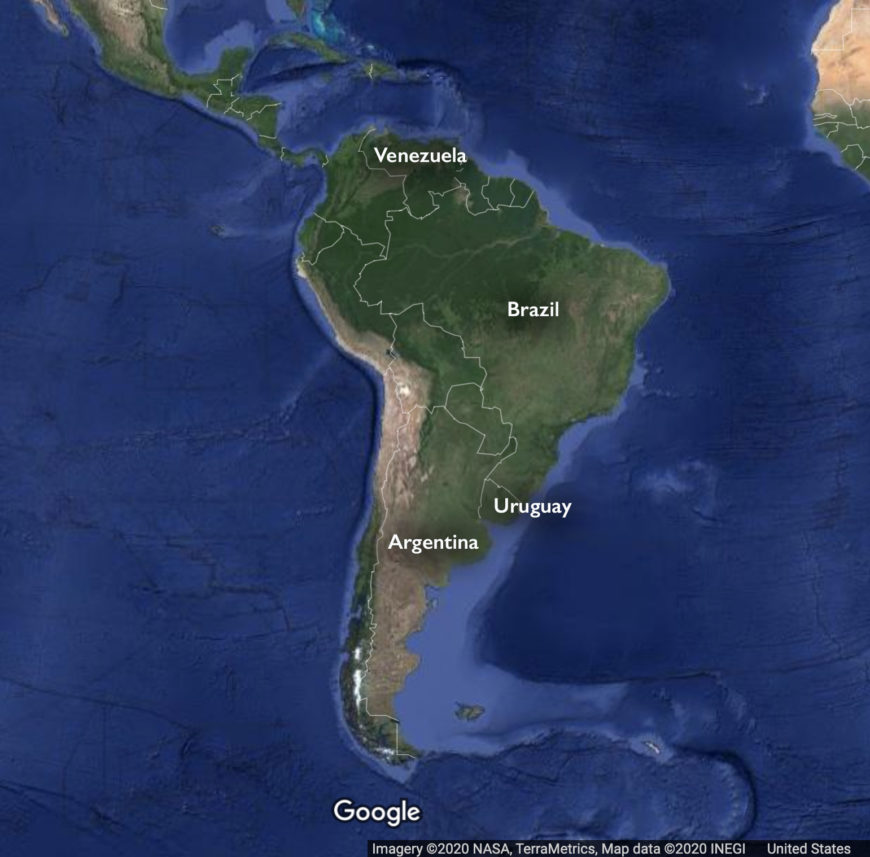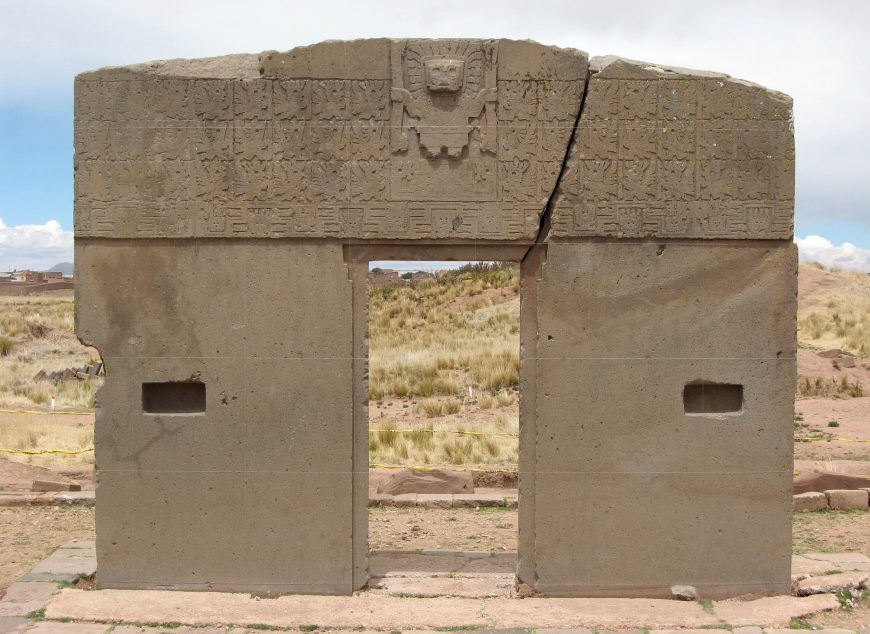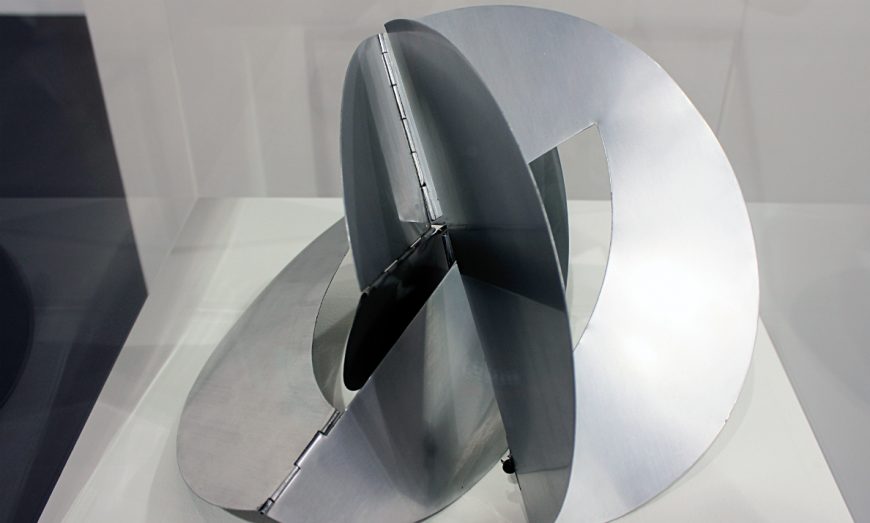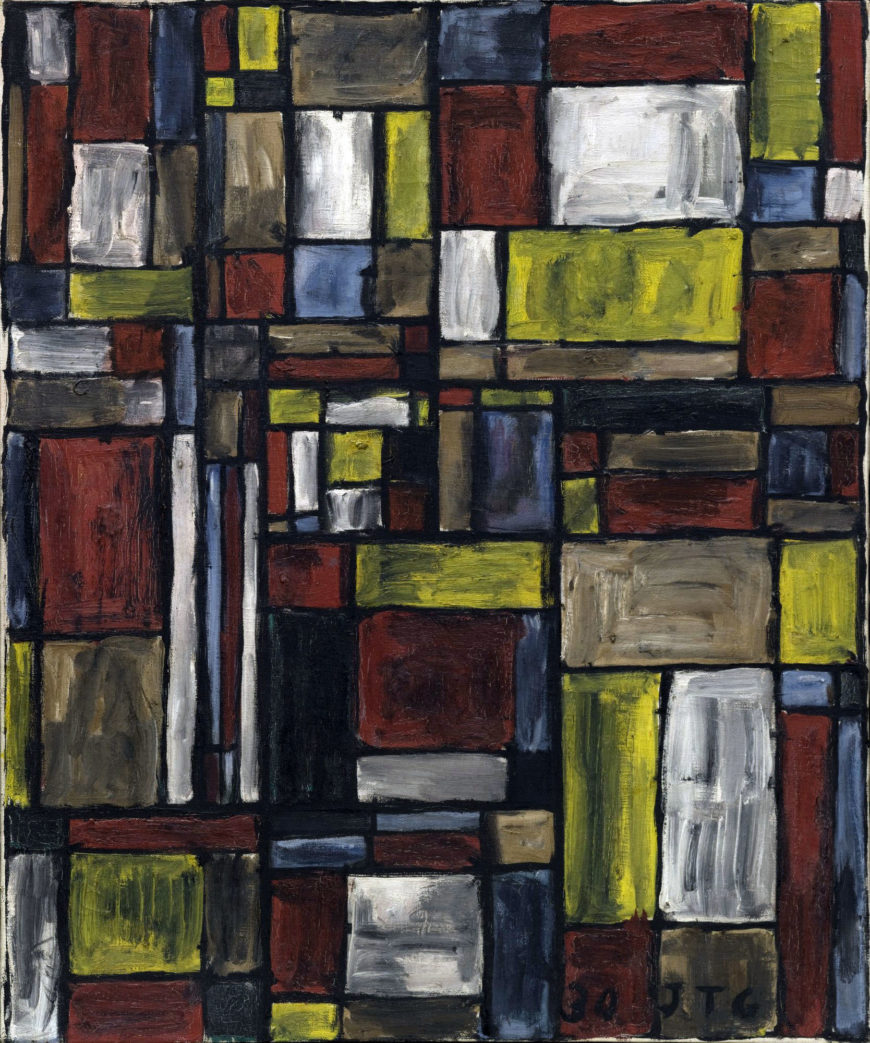
Joaquín Torres-García, Color Structure, 1930, oil on canvas, 24 x 20 inches (The Museum of Modern Art, New York)
During his decades spent living in Europe, Uruguayan artist and theorist Joaquín Torres-García experimented with several different artistic modes, including making representational paintings (depicting recognizable images) in a Neoclassical style or with bright colors and bold brushstrokes. While living in Paris, he would also come into contact with European geometric abstraction (abstract art based on geometric forms) and created a group with other artists he encountered there. He transitioned from making small toys and representational paintings to making geometric abstractions. He eventually returned to Uruguay and helped influence artists in Argentina, Brazil, and later, Venezuela to make art in this new modern style.
Geometric Abstraction rose to prominence in South America between the 1930s and the 1970s. Prior to this period, traditional representational art styles rooted in the traditions of academic painting were officially sanctioned and considered respectable in the region. This radical departure toward geometric abstraction was embraced by artists and state powers across Latin America as a way of culturally distancing themselves from the colonial past (c. 16th to early 19th century), while signifying their alignment with a new modern, economically independent future.
Joaquín Torres-García in Paris

Joaquín Torres-García, Color Structure, 1930, oil on canvas, 24 x 20 inches (The Museum of Modern Art, New York)
Like many Latin American artists of his generation, who lived, worked, and studied in Paris between World War I and II, Torres-García came to Paris because it was seen as the artistic capital of the West. While living there in the 1920s and early 1930s, he met Theo van Doesburg and Piet Mondrian, the Dutch founders of the art movement De Stijl (also known as Neoplasticism). Together, they formed the artistic group “Circle and Square,” which promoted geometric abstraction in opposition to Surrealism, an art movement based on dream-like imagery and the subconscious that was well known in France at the time. Torres-García was inspired by Mondrian, but was critical of De Stijl’s strict austerity. He wanted to propose a more “human” approach to geometric abstraction that would engage his interests in Latin American Pre-Columbian and European ancient and Classical art.
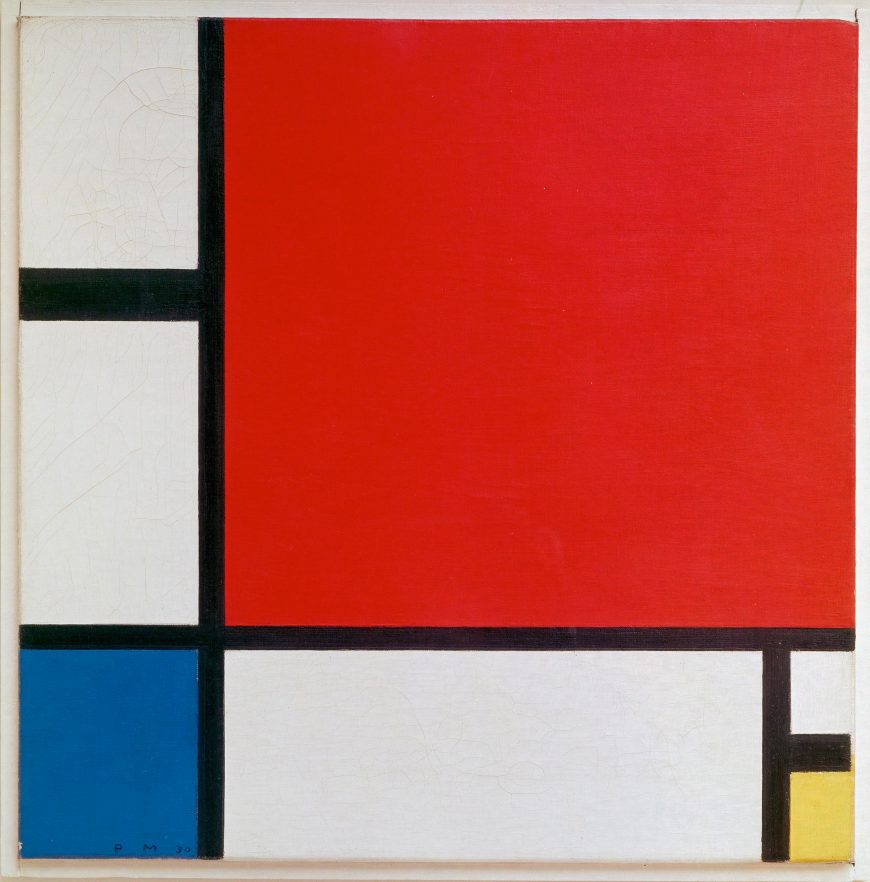
Piet Mondrian, Composition II in Red, Blue, and Yellow, 1930, oil on canvas, 46 x 46 cm (Kunsthaus Zürich)
Torres-García’s Color Structure, made in Paris in 1930, demonstrates his interest in many of the same principles as the Neoplasticists, including the grid, a reduced palette of primary colors, and the use of the Golden Ratio. These qualities are also evident in Mondrian’s Composition with Red, Blue, and Yellow (made the same year as Torres-Garcia’s Color Structure), a non-objective painting divided asymmetrically by thick black lines into squares of various sizes filled with flat planes of white and primary colors, the largest one, a bright red. Torres-García was inspired by De Stijl’s emphasis on the grid and Constructivism’s geometry, as well as what he believed to be the “universalism” of nonobjective art—in other words, he believed that geometric abstraction, which does not depict recognizable figurative imagery, could be visually understood across all cultures. In Torres-Garcia’s Color Structure, we also see a grid composed of different sized of rectangles in blue, yellow, white, and red, arranged vertically and horizontally.

A Fibonacci spiral that approximates the Golden ratio (diagram: Dicklyon)
Torres-García also adopted van Doesburg’s and Mondrian’s use of the Golden Ratio, an important concept to him, which he felt would help his art become integrated with natural and cosmic forces. But, unlike Mondrian, Torres-García emphasizes Color Structure’s imperfections: the grid is drawn freehand with wavy lines and the colors are muddy and include tonal variation and rough brushwork.
Constructive Universalism in Uruguay
When Torres-García returned home to Uruguay in 1934 (for financial reasons and the encouragement of friends), after more than forty years living abroad, he sought to bring geometric abstraction to Latin America as a way to reconcile this style with the region’s own cultural histories and artistic traditions. Dissatisfied with what he saw as a lack of emotion or humanity in Constructivism and De Stijl, he developed his own style called Universalismo Constructivo (Constructive Universalism), which sought to combine the “reason” of Constructivism’s and De Stijl’s geometry with the sources of abstract art found in the arts and crafts of ancient civilizations from around the world. He incorporated pictographs (simplified images or symbols) related to the cultures of various ancient civilizations (including Pre-Columbian cultures), into his images. He felt these pictographs communicated common ideas to people everywhere, making them “universal.”
As a cultural nomad who lived abroad in the U.S. and Europe for 43 years before returning to Uruguay, Torres-García was interested in the concept of “universalism” because he wanted to find visual elements that were shared by all cultures, underpinning his belief in the metaphysical wholeness of the universe. He also wanted to show how the geometric principles of pre-Columbian, Indigenous artistic styles actually anticipated later European geometric abstraction. His ideas paralleled psychologist Carl Jung, who believed that archetypal images could connect individuals to collective cultures and universal experiences. Torres-García was not relating to Jung directly, and for him, the metaphysical was much more important than the psychological. His search for the universal was not based on the psyche of the individual, but rather the universal collective.
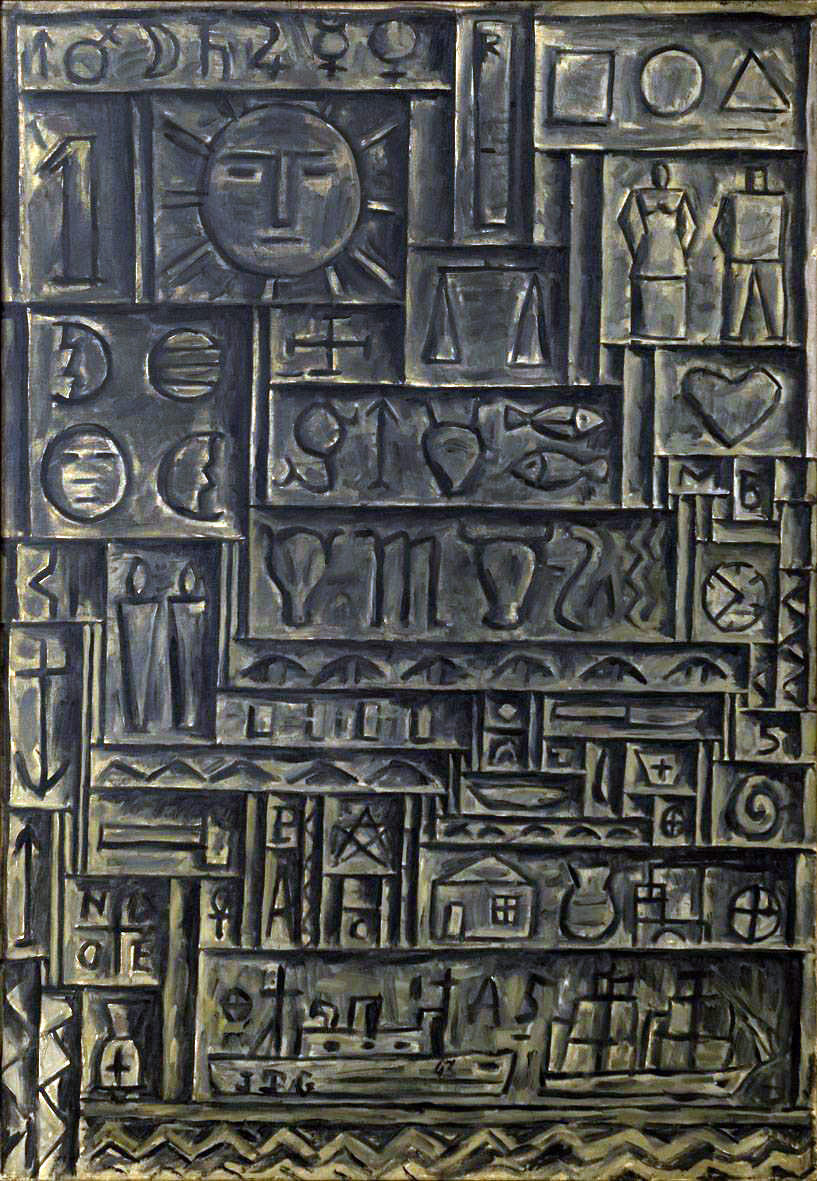
Joaquín Torres-García, Arte universal (Universal Art), 1943. Oil on canvas, 106 cm x 75 cm (Museo Nacional de Artes Visuales de Uruguay)
We find an expression of these impulses in his painting Universal Art, a composition in earthy browns depicting many interconnected rectangular compartments filled with pictographs, including shapes, symbols, and recognizable images such as the sun, the moon, scales, fish, a heart, a house, boats, and people, that appear as if they are carved into wood or stone. Like his earlier works that borrow from Mondrian, Torres-García creates an asymmetrical grid based on the Golden Ratio with a reduced color palette, but his earth tones convey more warmth, and his rough, painterly strokes and shading appear more “crafty” and reveal a human touch.
Later, Torres-García founded an arts and crafts workshop called the Taller Torres-García to disseminate his artistic theories to a younger generation of Uruguayan artists, whose style came to be known as the School of the South. Following Torres-García’s innovations in the 1930s and 1940s, artists across Latin America—especially in Argentina, Brazil, and Venezuela—began working in geometric abstraction, which would dominate the painting and sculpture in those countries until the 1960s and 1970s.
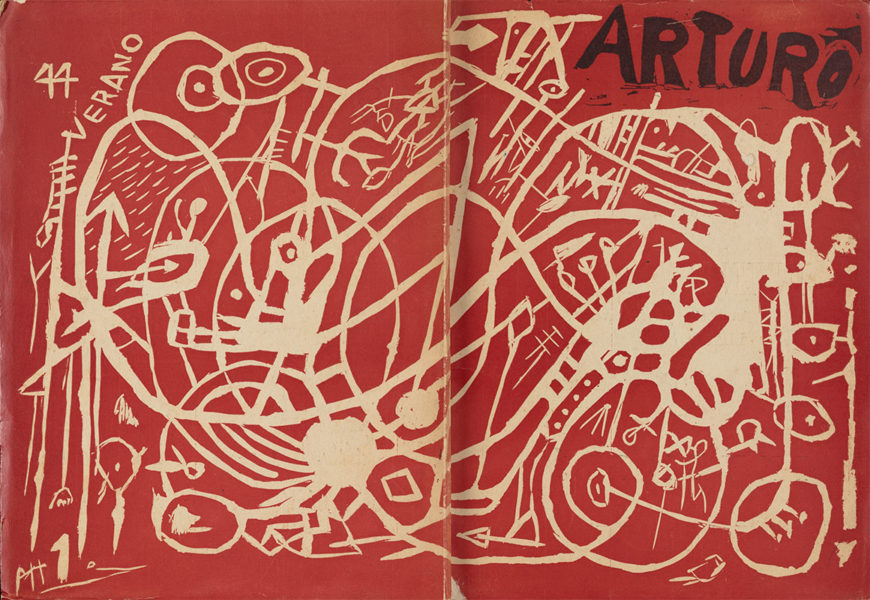
The cover of Arturo by artist Tomás Maldonado, an organic, abstract automatist woodcut, contradicts the kinds of constructive geometric abstraction being advocated inside the magazine’s pages, and demonstrates that this was still early on in the process of theorizing and practicing the new style. Tomás Maldonado, Arturo magazine cover, 1944
AACI and Madí in Argentina
In 1944, a group of Argentine and Uruguayan artists based in Buenos Aires published the first and only issue of a magazine about abstract art titled Arturo, with texts and reproductions of artworks by Torres-García, Mondrian, and the Russian abstract artist Wassily Kandinsky. The magazine was intended to promote Concrete Art (a term first used by Theo van Doesburg to describe nonobjective geometric abstraction) in Argentina.
Two Argentine Concrete Art groups emerged from the magazine: the Association of Concrete-Invention (AACI) and the Madí Group. These developments took place during the first term of the presidency of the Argentine populist Juan Domingo Perón, whose administration officially sanctioned naturalistic, figurative art styles, which these Concrete art movements fought against.
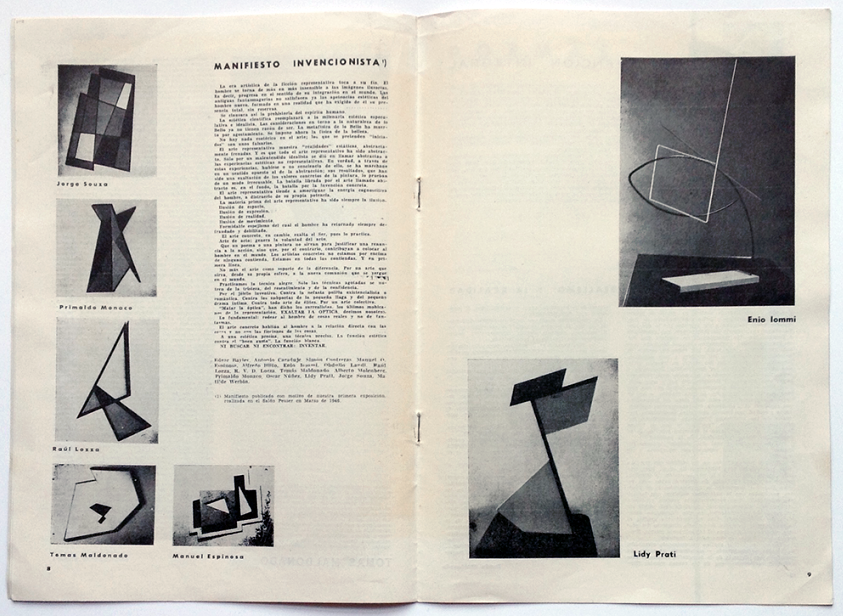
Inventionist manifesto alongside photographs of artworks, included inside the catalogue for the group’s first exhibition
AACI
The AACI was founded in 1945 by Argentine artist Tomás Maldonado and poet Edgar Bayley. The catalogue for the group’s first exhibition included their manifesto—a written statement declaring the group’s intentions, motives, and views—titled the “Inventionist Manifesto.” It called for artists to “invent” their own images, rather than trying to copy what they see, and justified Concrete art through Marxist political theories. [1]
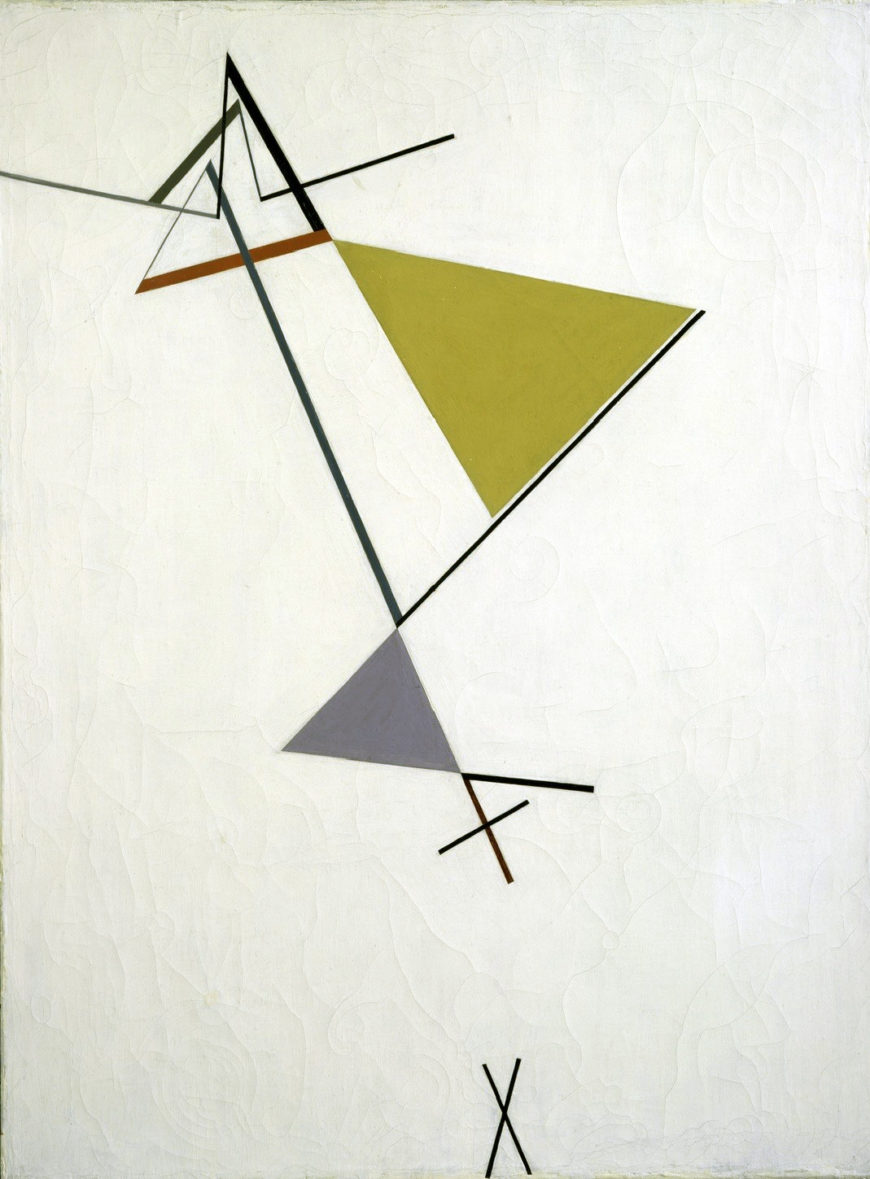
Tomás Maldonado, Development of a Triangle, 1949. Oil on canvas, 31 3/4 x 23 3/4 in (Museum of Modern Art)
Embracing Mondrian’s and van Doesburg’s strict Concrete aesthetics while rejecting Torres-García’s emphasis on symbolism and a hand-made aesthetic, the AACI emphasized a rigorous, mathematical, even mechanical-looking approach to geometric abstraction with flat, planar colors. These principles are on display in Maldonado’s Development of a Triangle a composition on a white ground of intersecting straight and angular lines and a series of triangles, one yellow and another violet. [2]
Madí Group
In 1946 the Madí Group was formed by artists Rhod Rothfuss, Carmelo Arden Quin, and Gyula Kosice. [1] Like the AACI, Madí endorsed making nonobjective artworks with flat planes of bright color. But, unlike the AACI, Madí art was more playful and experimented with three-dimensions and unusual materials such as Plexiglas and neon.
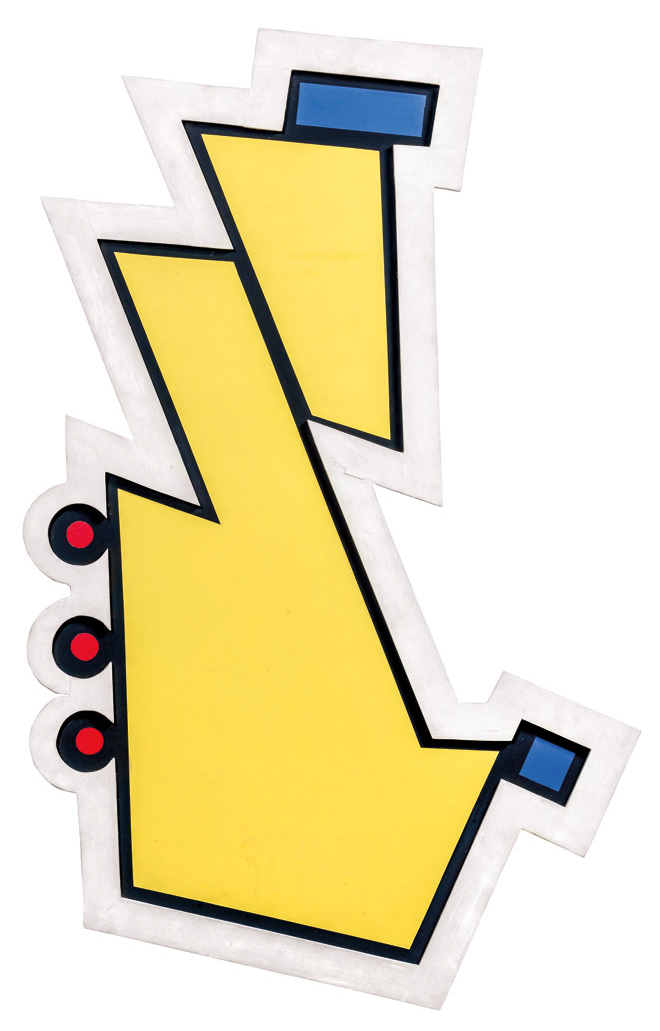
Rhod Rothfuss, Tres círculos rojos (Three Red Circles), 1948, filler and enamel on wood, 100 x 70 cm (Museu de Arte Latino-Americana de Buenos Aires)
Madí artists often rejected the traditional rectangular picture frame in favor of an irregularly-shaped canvas, known as a marco recortado (cutout frame). The cutout frame was first conceived by Rothfuss in an essay he wrote for Arturo, in which he argued that irregularly-shaped canvases would allow artworks to function like other objects in the world, rather than as windows framing views of another world. One example of the cutout frame is Rothfuss’s Three Red Circles, a bright yellow geometrically-shaped composition with shapes delineated with thick black lines, a blue rectangle at the top and on the side, and three small red circles on the left.
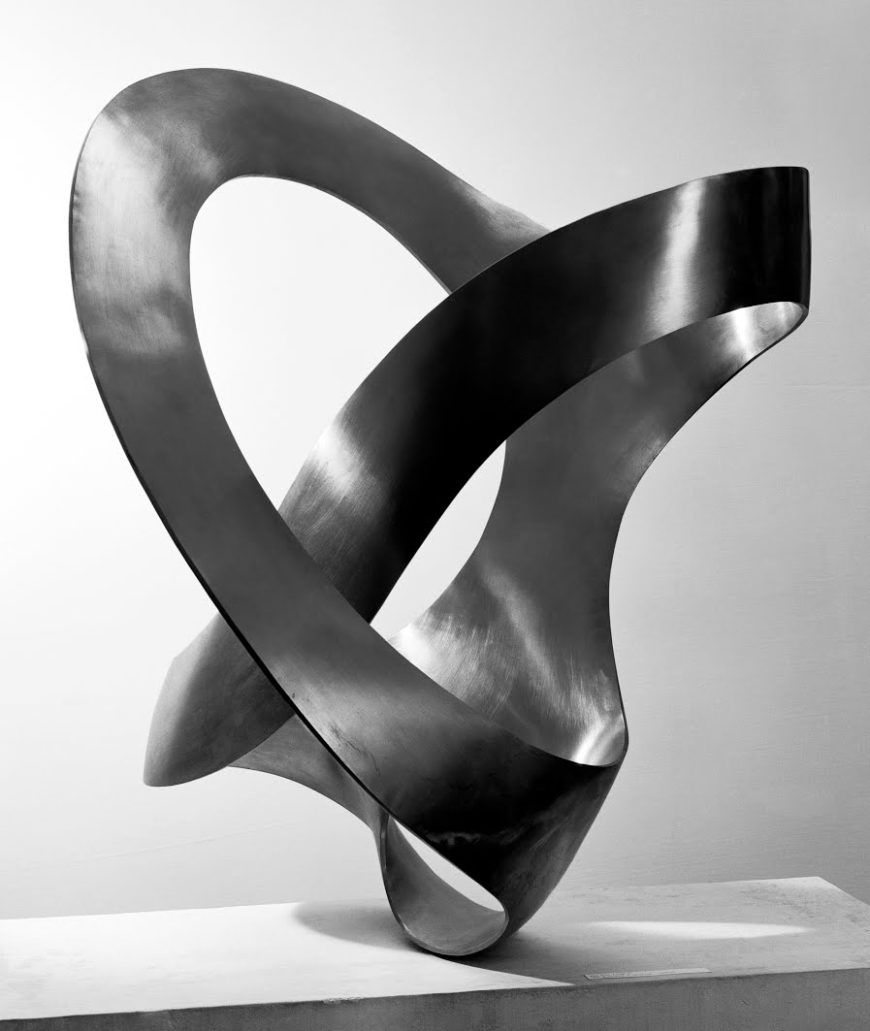
Max Bill, Tripartite Unity, 1948–1949, stainless steel, 113,5 cm x 83 cm x 100 cm (Museu de Arte Contemporânea de Universidade de São Paulo)
Concrete and Neo-Concrete Art in Brazil
Max Bill
In 1951, Swiss Concrete artist and former Bauhaus student Max Bill won the grand prize for sculpture at the First São Paulo Biennial (a large international exhibition occurring every two years) in Brazil, for his metallic sculpture of flowing, intertwining ribbon-like forms, called Tripartite Unity. This sculpture would influence a young generation of Concrete artists in the country, including the Grupo Ruptura in São Paulo and the Grupo Frente in Rio de Janeiro. Concrete art captured the values of science and mathematical precision heralded in Brazil in the 1950s, a period of rapid industrial growth, modernization, and the development of a new capital in Brasília defined by architect Oscar Niemeyer’s futuristic International Style architecture.
The Grupo Ruptura
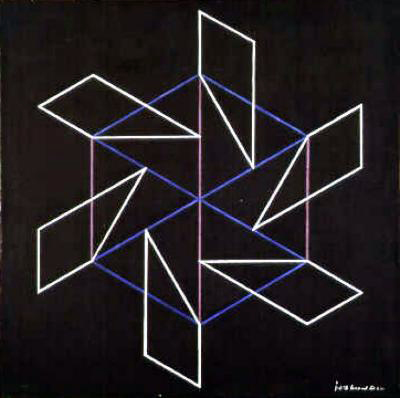
Judith Lauand, Espaço Virtual (Virtual Space), 1960. Tempera on canvas, 45 cm x 45 cm x 2.7 cm (Museu de Arte Contemporânea de Universidade de São Paulo)
The Grupo Ruptura was formed in 1952 with an exhibition at the Museum of Modern Art of São Paulo. The group’s name meant “rupture,” and it sought to break with traditional art styles, namely naturalistic painting, which was seen as elitist (though this break was not specifically tied to political radicalism). Their works were characterized by flat colors and a reduced palette, geometry, and industrialized media like enamels and mechanical techniques like spray painting that would not reveal the hand of the artist. Their works also incorporated Gestalt psychological theory (a perceptual theory about how the brain forms a whole image from many component parts) by training the viewer’s eye on outlines as contours of a solid shape, as in Judith Lauand’s Virtual Space, a painting of a pinwheel-like shape of white and purple lines in a field of black. Lauand was also the only woman in the Grupo Ruptura.
The Grupo Frente and Neo-Concrete art
The Grupo Frente was founded by artist and teacher Ivan Serpa in Rio de Janeiro in 1954. Many of the artists involved were his former students at the Museum of Modern Art of Rio de Janeiro. They rejected the Grupo Ruptura’s strict adherence to purity, science, and math and promoted instead more creative intuition in geometric abstraction. This shift in the Grupo Frente’s brand of Concrete art eventually led to a new style altogether, known as Neo-Concrete art, pioneered by artists Lygia Clark, Lygia Pape, and later, Hélio Oiticica.
The principles of Neo-Concrete art were theorized by poet Ferreira Gullar in his “Neo-Concrete Manifesto” (1959), which called for more sensuality, freedom, and feeling in Concrete art. Like Torres-García who sought to infuse geometric abstraction with more emotion, the manifesto sought to distance the new movement from the dogmatic rationalism of European Concrete art styles like Neo-plasticism and Constructivism.
Gullar also developed the theory of what he termed the “non-object,” by which he meant an art object that would function as a mediator between the spectator and the physical experience of the object. This is exemplified by Lygia Clark’s Bicho (Critter), a metal sculpture made of moveable flaps intended to be manipulated and rearranged by the spectator-participant (or someone who observes and participates). As Clark’s Bicho suggests, Neo-Concrete art adapted Concrete art’s geometric shapes and transformed them into organic three-dimensional objects to be handled by spectators, or environments to be physically entered, which helped to break down boundaries between art and life in Brazilian art of the 1960s.
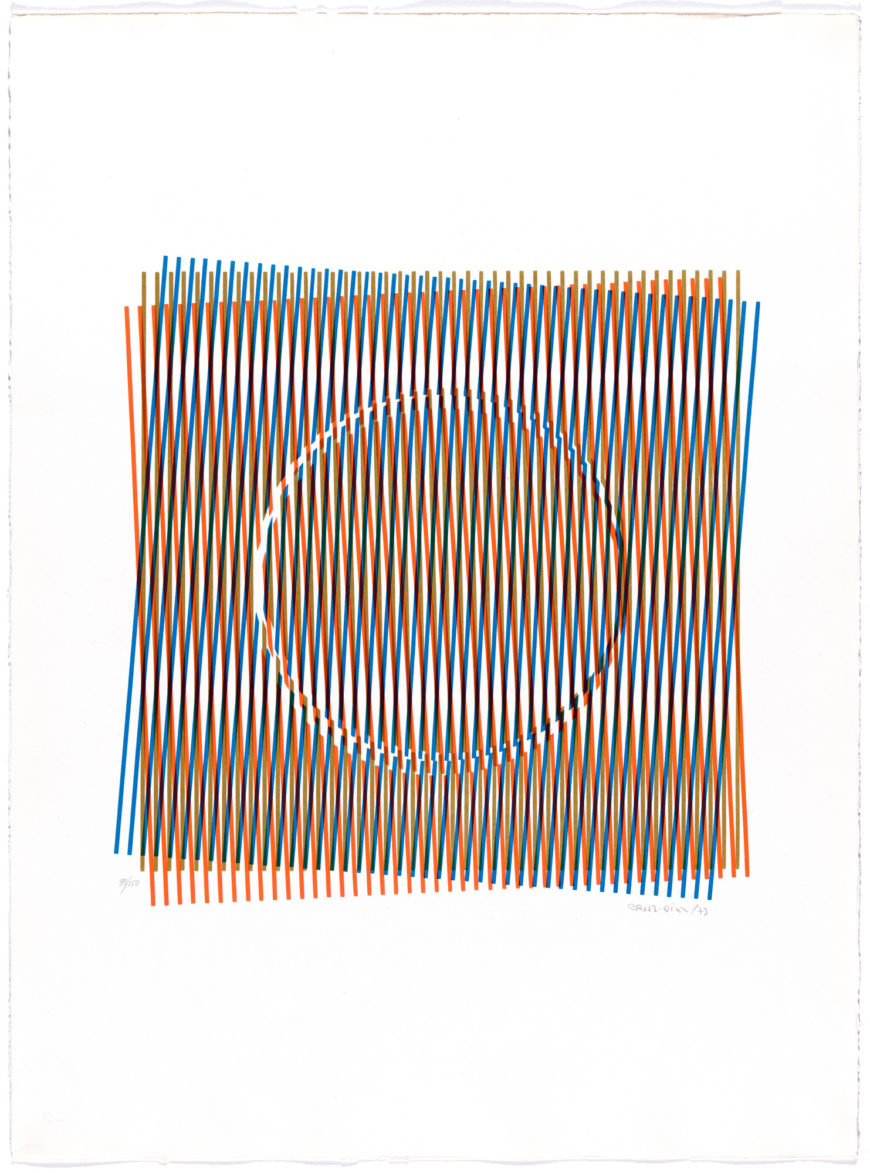
Carlos Cruz-Diez, Chromo-Interference (Cromo Interferencia), from AGPA 73: Pan American Graphic Arts (AGPA 73: Artes gráficas panamericanas), 1973, screenprint, 43 x 42.5 cm (Museum of Modern Art)
Optical and Kinetic Art in Venezuela
Two other forms of geometric abstraction, known as Optical (or Op, a style of abstract art based on patterns and optical illusions) and Kinetic art (objects that have moving parts), became popular in Venezuela in the 1950s and 1960s. These styles were dominated by three artists in the country: Carlos Cruz-Diez, Alejandro Otero, and Jesús Soto. Their works included small and large-scale abstract sculptures and public artworks made of bright colors and industrial materials that moved, or appeared to move.
Jesús Rafael Soto, Penetrable BBL Bleu, conceived 1999, given to LACMA in 2020 (Los Angeles County Museum of Art)
A famous example are Soto’s “penetrables,” tubes of colored plastic suspended from the ceiling in box-like shapes, into which participants could enter and play. While Brazilian Neo-Concretists sought to move away from the purely optical toward the experiential and sensual, the Venezuelans still embraced the visual, but also created participatory and sensually experiential environments and objects to be interacted with, like Soto’s penetrables.
The Op and Kinetic works by these artists received corporate and government support from the Venezuelan regime of Colonel Marcos Pérez Jiménez’s dictatorship of the 1950s, as well as later democratically elected administrations in the 1960s and 1970s, and resulted in the commissions of several large-scale public artworks. The state and corporate leaders believed such works helped position Venezuela on the world stage as a modern, forward thinking, and technologically advanced country. This was important to them as they were growing their oil industry for international export. These works were used by corporations and the state as propaganda promoting Venezuela as an international modern center of industry, revealing how state-patronage and nationalist interests intervened in the so-called “avant-garde” art in the country during the period.
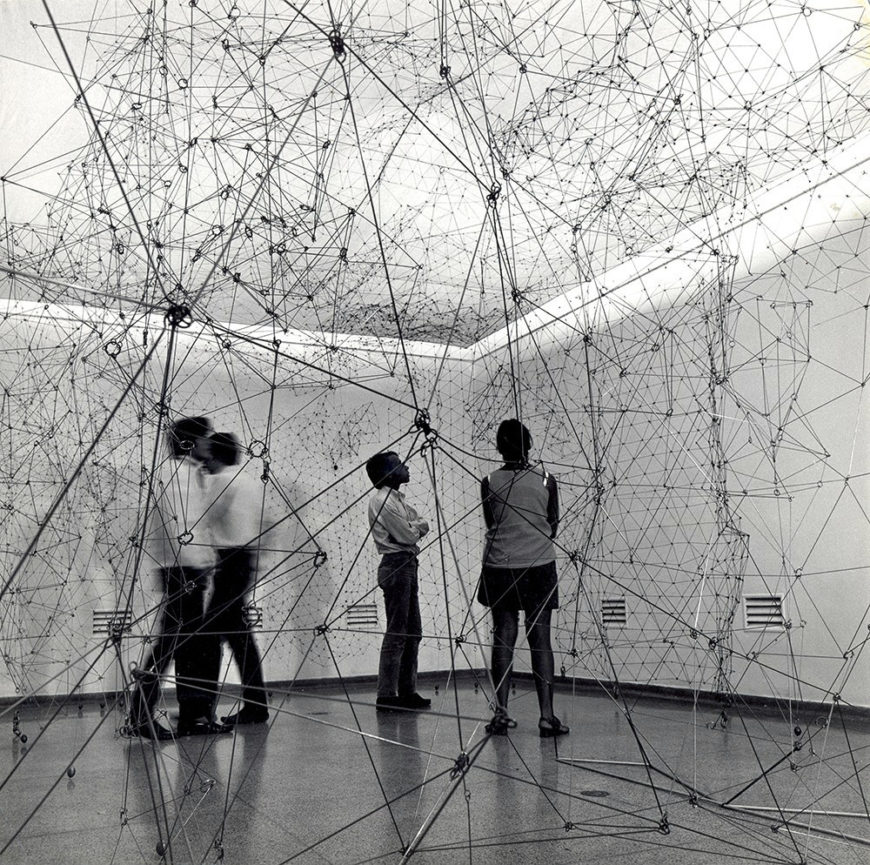
Gego (Gertrude Goldschmidt), Reticulárea (ambientación), 1969, installation view Museo de Bellas Artes Caracas, 1969 (photo: Paolo Gasparina © Fundación Gego)
Another important artist in the history of Venezuelan abstraction was Gego (Gertrud Goldschmidt), a German emigrant, who developed her own approach to geometric abstraction, creating delicate sculptures and environments (sculptures that occupy entire gallery spaces) made of wire. Gego’s large Reticulárea (Reticular), created at the Museo de Bellas Artes in Caracas in 1969, comprises a sprawling wire grid that filled the gallery’s floor, walls, and ceiling, into which spectators could enter and walk around.
Contributions and Legacy
Latin American geometric abstraction united international principles of modernist abstraction with local cultural traditions, and led to more participatory forms of art. It also served as an ideological tool for both Latin American artists and nation-states to signal a break with traditional art styles—associated with their colonial past—and to assert a new, modern, and often utopian industrialized future. Latin American geometric abstraction is probably most notable for the large number of women artists who were leaders in these movements and who achieved successful artistic careers in their lifetimes, something that was much less common with mid-twentieth century art movements in the U.S. and Europe. [3]
Notes:
[1] Their formulation of “Concrete-Invention” was rooted in their commitment to Marxist materialism and anti-idealist revolutionary and collective art.
[2] The term “Madí” has various purported origins: it may have represented the combination of the first syllables (in Spanish) of the term “dialectic materialism,” it may have been an abbreviation of “Madrid,” or it could have been an acronym for “Carmelo Arden Quin.”
[3] In addition to the women artists mentioned in this article, Judith Lauand, Lygia Pape, Lygia Clark, and Gego, were many others, including Lydi Prati, Mira Schendel, Fanny Sanín, María Freire, Amalia Nieto, and Mercedes Pardo.
Additional resources:
Check out installation photos from MoMA’s Sur moderno exhibition
Watch three videos from the Getty about Concrete art that discuss breaking the frame, painting in an industrial age, and the challenge of a straight line
Gabriel Pérez-Barreiro, “Concrete Art in Latin America.” Grove Art Online, March 26, 2018.
David Fernando Cortés Saavedra, “Geometric Abstraction and Concrete Art in South America.” Routledge Encyclopedia of Modernism, September 5, 2016.
Alexander Alberro, Abstraction in Reverse: The Reconfigured Spectator in Mid-Twentieth-Century Latin American Art (Chicago: University of Chicago Press, 2017).
Mónica Amor, Theories of the Nonobject: Argentina, Brazil, Venezuela, 1944–1969 (Oakland, CA: University of California Press, 2016).
Yve-Alain Bois, et al. Geometric Abstraction: Latin American Art from the Patricia Phelps de Cisneros Collection (New Haven, CT: Yale University Press, 2001).
Dan Cameron, Kinethesia: Latin American Kinetic Art, 1954–1969 (Palm Springs, CA: Palm Springs Art Museum, 2017).
María Amalia García, Abstract Crossings: Cultural Exchange between Argentina and Brazil (Oakland, CA: University of California Press, 2019).
Aleca Le Blanc and Pia Gottschaller. Making Art Concrete: Works from Argentina and Brazil in the Twentieth Century in the Colección Patricia Phelps de Cisneros (Los Angeles: Getty Publications, 2017).

